FOR AUTOMOTIVE ENTERPRISE
(1) INTRODUCTION
As you may know, the automotive industry involves a wide range of supporting industries. In the field of industrial designs (hereinafter simply referred to as "design"), there is no doubt that automotive designs are the stars of product designs.
However, the automotive industry has also been undergoing a so-called greatest paradigm shift of the century, which will of course make a considerable impact on the future trends of the design industry.
In order to keep up with the cutthroat competitions and abrupt changes in the future automotive industry, it will be additionally necessary to enhance your competence in design right by, for example, creating a design conducive to desired functions and developing the concept of appearance that allows your product to be clearly distinct from other companies' products.
On this page, we would like to discuss particularly about the designs of "automobiles", which belong to G2-2 of Group G (TRANSPORT AND CONVEYANCE MACHINERY) - G2 (VEHICLES) stipulated in the Japanese Classification for Industrial Designs.
As the designs of "automobiles", for example, the following items can be registered.
| G2-2100 | : | PASSENGER CARS AND THE LIKE |
| G2-29000 | : | PARTS AND ACCESSORIES FOR AUTOMOBILE |
| G2-29100 | : | LARGE COMPONENT PARTS OF BODY FOR AUTOMOBILE |
| G2-292 | : | DRIVING PARTS FOR AUTOMOBILE AND PARTS RELATED TO RUNNING FOR AUTOMOBILE |
| G2-29300 | : | PARTS AND ACCESSORIES RELATED TO DRIVING OPERATION FOR AUTOMOBILE |
| G2-2940 | : | PARTS AND ACCESSORIES FOR SECURITY FOR AUTOMOBILE |
| G2-29500 | : | PARTS AND ACCESSORIES FOR EXTERIOR TRIM FOR AUTOMOBILE |
| G2-29600 | : | PARTS AND ACCESSORIES FOR INTERIOR TRIM FOR AUTOMOBILE |
| G2-2970 | : | AUTOMOTIVE LIGHTING EQUIPMENT |
This page is intended to support automotive enterprises from the viewpoint of intellectual property management.
(2) WHOLE DESIGN OF "AUTOMOBILE"
When you think about automotive designs, what comes to your mind first? Probably, it is the design of a whole automobile. Since every automotive manufacturer has a unique character, many consumers feel attachments to the design of an automobile that represents the manufacturer's character. Meanwhile, the field of automotive designs is strictly restricted by various standards, laws, and regulations. Recent years have seen an increasing demand for development in automotive design in regard to functionality (e.g., recyclability of components and fuel efficiency). The following are examples of registered designs of light automobiles that are especially strictly restricted. Many female drivers own these cars as third eco-cars, because these cars secure a wide inner space despite the limited dimensions, and considerations have been paid to their appearances so that their designs meet women's needs.
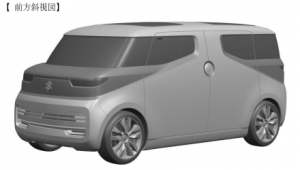
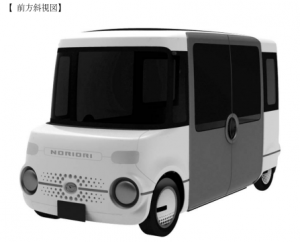
[Design Registration No.] 1550817 [Design Registration No.] 1549297
[Holder of Design Right] SUZUKI MOTOR CORPORATION [Holder of Design Right] DAIHATSU MOTOR CO., LTD.
(3) "PARTIAL DESIGN" AND "DESIGN OF COMPONENT" OF AUTOMOBILE
In view of branding, automotive manufacturers tend to strategically employ, for example, a uniform design for the front face. The front part of an automobile corresponds to the front view of the whole automobile. Therefore, once the design of an automobile is registered as a whole design such as that introduced in the above item (2), the design of the front part of the automobile is of course included in the scope of the right of the registered whole design. However, in a case where (i) an automobile manufactured by your competitor has a front part that is similar in design to that of your automobile a design of which has already been registered as a whole design but (ii) the automobile of your competitor is not similar to your automobile in terms of an overall sense, the design of the front part of your automobile may not be sufficiently protected by the right of the whole design. Therefore, in filing a design application for a whole design of your automobile, it is also suggested to file another design application for the "partial design" of your automobile so as to obtain a stronger design protection, which in turn will allow reinforced protection of your brand.
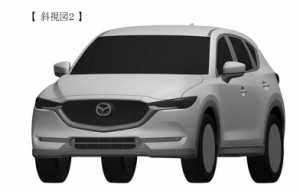
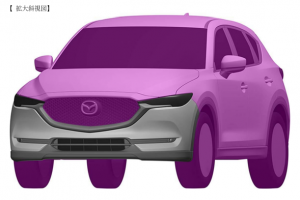
[Design Registration No.] 1568234 [Design Registration No.] 1568235
[Article to Design] Passenger Car
[Holder of Design Right] Mazda Motor Corporation
The design on the right (No. 1568235) is a partial design.
[Explanation of Design] The part other than the pink-colored part in the drawing is registered as a partial design.
In regard to the design of the above automobile, the design of the front grille, which takes a large role of the front design, is also registered as a different "component" design. This proves their high awareness of protection of design rights.
Such a strategy for design right protection is not limited to a complete automobile. It is also meaningful to consider registration of the design of a part (component).
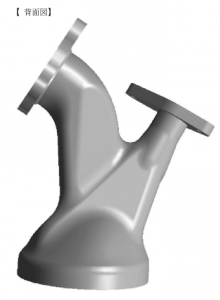
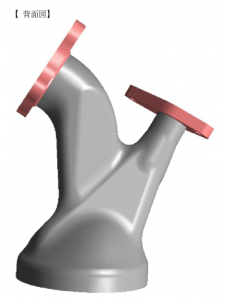
[Design Registration No.] 1361771 [Design Registration No.] 1361772
[Article to Design] Exhaust for Internal Combustion Engines
[Holder of Design Right] MITSUBISHI MOTORS CORPORATION
[Explanation of Article to Design] The present article is an exhaust including a supply passage via which an additive is supplied to an exhaust passage that connects an internal combustion engine to an exhaust component such as a catalyst converter or a muffler. *The drawing on the right is a partial design.
As is clear from the above examples, importance of partial design registration resides not only in exterior trims but also in interior components. Generally, a design needs to be of an article that is visually recognizable, so as to be regarded as the target of protection. Therefore, components that do not appear in the outer appearance of a complete automobile are not regarded as the subject of protection as a design of the automobile. However, although such interior components serve as "background roles" that support the structure and function of an automobile, they are also distributed as "articles (components)" in the market before being incorporated into an automobile, and they are also needed as replacement parts for repair. Particularly in recent years, more and more counterfeit products of such components are produced in many countries. Therefore, when you develop a component having a new shape, it is important to consider acquiring protection of the component under design rights, while comprehensively taking the cost-benefit performance into consideration. Furthermore, commonality and modularization of components will be further advanced due to the paradigm shift. "HARAKENZO more " believe that this will further increase the value of acquiring multi-layered protection for the design of a "component".
(4) "DESIGN INCLUDING DESIGN" OF AUTOMOBILE
Since the car navigation system has become popular as a standard feature, the demand for development of the function and design of in-car liquid crystal displays is becoming non-negligible. Meanwhile, the connected automobile, which serves as an information terminal of the IoT technology, includes an integrated communication information system called "car telematics". This means that the graphical user interface (GUI) will take an important role in the appearance of the interior decoration and operability of an automobile. According to the Examination Guideline for Design which underwent the revision on April 1, 2016, so-called version upgrades and installed images can also be protected if certain conditions are satisfied. As such, the importance of design including the image will surely increase in the field of automotive industry.
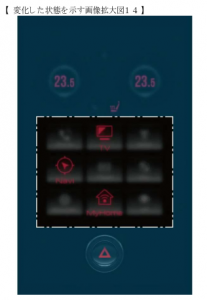

[Design Registration No.] 1576603 [Design Registration No.] 1516341
[Article to Design] In-car Information Display Device [Article to Design] In-car Device Operating Device With In-car Display
[Holder of Design Right] Panasonic Intellectual Property Management Co., Ltd.
[Holder of Design Right] DENSO CORPORATION
Both are partial designs.
The design No. 1576603 is classified intoH7-6243 "Small Data Display Equipment" of H7 "Electrical Information Input/Output Equipment".
(5) COMBINATION WITH OTHER INTELLECTUAL PROPERTIES SUCH AS PATENT AND TRADEMARK
Typically, enterprises that place importance on intellectual property strategies attempt to separately establish (i) their technical superiorities by "patent" and "design" and (ii) their brands by "trademark" and "design", so that different protection jurisdictions will complement each other. Although not specifically explained on this page, for example, the company that filed the design application for the above design (which is related to an exhaust for internal combustion engine introduced in the above item (3)) also filed, in the same period of time, a large number of patent applications related to an exhaust air purifying device. This means that the company had understood what is protected by each jurisdiction well, and thus attempted to achieve a "BEST MIX" of intellectual properties that can complement each other.
Our intellectual property specialists will help you in achieving such a "BEST MIX" for each specific case, so that your intellectual properties, which are the essential elements for your company's growth, will be effectively protected and utilized.
(6) DETERMINATION AND TIMING OF APPLICATION IN GLOBAL ERA
Typically, not only complete automobiles but also automotive components are globally rolled out in the field of automotive industry, which is a key industry that occupies 20% of the total exports from Japan and which involves development, manufacturing, and distribution of products all over the world. This means that it is necessary to carefully consider (i) in which country, (ii) for which design, and (iii) when a design application should be filed. As compared with patents and trademarks, design systems have not been harmonized among the countries. Therefore, it should be noted that various design systems, which largely differ from country to country, are employed around the world regardless of developed and developing countries. If you are going to roll out a design in multiple countries, it is necessary to sufficiently consider (i) when the design should be introduced, (ii) in what order design applications should be filed in those countries, and (iii) whether it is possible to utilize the design systems of those countries. For example, some countries do not have the "Secret Design" system which is employed in Japan. In some countries, a design is published immediately after application thereof without any substantial examination being carried out. As such, haphazard measures may disable acquisition of necessary rights and end up with undesirable results. It is therefore necessary to sufficiently consider the strategy with the assistance of specialists that are fully conversant with foreign design systems.
(7) OTHERS (DESIGN FOR SET OF ARTICLES, RELATED DESIGN, AND SECRET DESIGN)
Design of Set of Articles
The Japanese Design Act is based on the "one-design-per-article" principle. However, limited 56 kinds of set of articles that are used together are exempted from this principle. The design of such a set of articles is protectable as a "design for set of articles", which can be acquired by a single application. The following are the examples of the set of articles related to the automotive industry.
- Set of Automobile Air Spoilers - *Automobile Air Rectifiers (two or more)
- Set of Automobile Seat Covers - *Seat Covers (two or more)
- Set of Automobile Floor Mats - *Floor Mats (two or more)
- Set of Automobile Pedals - *Gas Pedal and Brake Pedal
- Set of In-Car Route Guiding Device - *In-Car tuner, In-Car Amplifier, and Speaker Box
- Set of In-Car Audio Devices - *In-Car tuner, In-Car Amplifier, and Speaker Box
Related Design
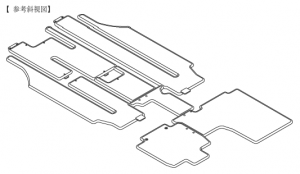
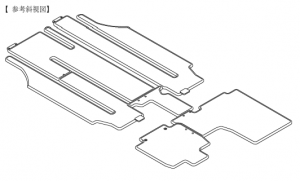
[Design Registration No.] 1324978 (Main Design) [Design Registration No.] 1325367 (Related Design)
[Article to Design] Set of Automobile Seat Covers (Both)
[Holder of Design Right] Honda Access Corporation (Both)
The above two designs are registered as "Main Design" and "Related Design" by the same right holder. The scope of a registered design encompasses not only identity but also similarly. Therefore, effective utilization of the related design system will make it possible to acquire a design right with a further broader scope.
Secret Design
The following list includes ten designs that were recently registered by Toyota Motor Corporation (from the Design Gazette of December 1, 2017) including those acquired by joint applications.

As is clear from the above, no drawing and no name of article are published in regard to four of the ten designs. This means that the "secret design" system mentioned in the above item (6) is utilized.
The secret design system makes it possible to adjust the timing of publication of a registered design within three years from the date of registration, and therefore allows integration of intellectual property strategies and market strategies.
(8) "HARAKENZO more " SUPPORT AUTOMOTIVE ENTERPRISES
The automotive industry is said to undergo the greatest revolution of the century. Under the circumstances, we believe that the industry will reborn as the key industry that will produce many chances through incorporation of new ideas and attempts. The revolution will also make it possible to develop new fields by sublimating existing technologies and simultaneously rolling out such technologies. As a large-scale, international, and full-service intellectual property firm, we have cultivated not only rich experience in global intellectual property practice but also plentiful knowledges and viewpoints for various industry fields. With the experience and knowledges, we are committed to making our best effort to support automotive enterprises to make new strides, as the business strategy adviser in the field of intellectual property. Please feel free to contact us for any consultation.
意匠の疑問・お悩みはHARAKENZOに相談ください!

意匠登録や意匠トラブルの解決にあたっては、専門家の判断が欠かせません。
意匠のことでお悩みがありましたら、いつでも知的財産のプロフェッショナル集団であるHARAKENZO事務所にご相談いただけます。
